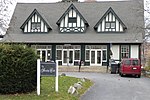Chanticleer Garden
1912 establishments in PennsylvaniaBotanical gardens in PennsylvaniaColonial Revival architecture in PennsylvaniaHouses completed in 1912Houses in Delaware County, Pennsylvania ... and 5 more
Houses on the National Register of Historic Places in PennsylvaniaNational Register of Historic Places in Delaware County, PennsylvaniaProtected areas of Delaware County, PennsylvaniaRadnor Township, Delaware County, PennsylvaniaWoodland gardens

Chanticleer Garden is a forty-eight-acre botanical garden built on the grounds of the Rosengarten estate at 786 Church Road in Wayne, Pennsylvania. Located on Philadelphia's historic Main Line, Chanticleer retains a domestic scale and is welcoming to visitors for relaxation, walking, and picnics. The grounds became open to the public in 1993. Visitors are welcome to tour the estate seasonally, from April through October. The house and grounds were added to the National Register of Historic Places in 1984.
Excerpt from the Wikipedia article Chanticleer Garden (License: CC BY-SA 3.0, Authors, Images).Chanticleer Garden
Abrahams Lane, Radnor Township
Geographical coordinates (GPS) Address Nearby Places Show on map
Geographical coordinates (GPS)
| Latitude | Longitude |
|---|---|
| N 40.0305 ° | E -75.386555555556 ° |
Address
Abrahams Lane
Abrahams Lane
19085 Radnor Township
Pennsylvania, United States
Open on Google Maps










